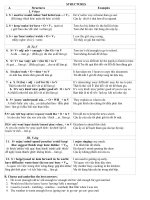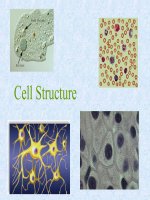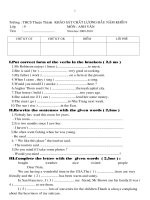Cell Structure
Bạn đang xem bản rút gọn của tài liệu. Xem và tải ngay bản đầy đủ của tài liệu tại đây (1.61 MB, 25 trang )
Cell Structure
History of the Cell - Scientist were aware of
cells only after the discovery of microscopes.
“Guys” who contributed to cell theory:
•Hooke (1665) – coined term ‘cell’
•Van Leeuwenhoek – viewed first living cells
•Schleiden (1838) – plants are composed of
cells
•Schwann (1839) – animals are composed of
cells
•Virchow (1858) – cells come from cells
Cell theory which states:
1. All living things are composed of one
or more cells.
2. In organisms, cells are the basic units
of structure and function.
3. Cells are produced only from existing
cells.
ALL cells share certain structural
characteristics:
1. Cell or Plasma membrane
2. Cytoplasm
3. Genetic Material
1. Cell or plasma membrane –
•Composed of lipid bilayer and
proteins.
•Separates the cell contents from
materials outside the cell.
•Regulates what enters and leaves the
cell, maintaining homeostasis; called
selectively permeable.
Cell Membrane
2. Cytoplasm – gel-like substance that
suspends organelles and contains sugars,
amino acids, and proteins.
•Contains Organelles – membranebound internal compartments that carry
out specific functions.
•Contains free-floating ribosomes.
Site of protein synthesis (where
proteins are made).
Not considered organelles because
they have no membranes surrounding
them.
Ribosomes: the little
black dots!
Genetic material:
•Composed of DNA
•Controls reproduction of cell, contains hereditary
information, and carries out the day-to-day
cellular activities.
•In eukaryotic cells, DNA surrounded by a double
membrane (nuclear membrane) is the
Nucleus.
•Nuclear membrane is passageway for RNA and
ribosome subunits.
•Nucleus contains chromosomes (DNA superwound around histone proteins into highly
condensed form)
•Nucleolus – where ribosome subunits are made.
DNA: chromatin
Nuclear
membrane and
pores
Plant nucleus
Nucleolus
The Interior of a Cell:
Internal Membranes (double layer of lipids):
1. Endoplasmic reticulum (ER)
• Series of channels that weave through the
cell transporting substances made by the
cell
• Isolated spaces of ER forming sacs are
called vesicles
a. Rough ER – ER that contains ribosomes
on the outside and carry proteins.
b. Smooth ER – ER with no ribosomes on
the outside and carry lipids.
Rough ER
Sorry, no pictures
of smooth ER.
Vesicles
2. Golgi apparatus (bodies) – collect,
package, and distribute molecules made
in the cell.
Golgi bodies
Powerhouses:
1. Mitochondria
• Contains folded membranes called
cristae (increases surface area).
• Generate energy for the cell through
cellular respiration.
2. Chloroplast:
• Consist of stacks of membranes called
grana surrounded by liquid called
stroma.
• Sites of photosynthesis (make food in
form of sugar) in plants and algae.
Chloroplasts
Grana
Stroma
Central Vacuole
Biochemical factories - membrane-bound spheres
1. Peroxisomes:
• Some contain enzymes that convert fats to
carbohydrates
• Some alter harmful molecules to harmless
molecules
2. Lysosomes
• Contain digestive enzymes to breakdown
proteins, nucleic acids, lipids, and carbohydrates
• Digest and recycle the cell’s used component
Lysosome
Internal framework
A. Microtubules - hollow protein fibers that
makeup:
1. Cytoskeleton: support shape of cell and
anchor organelles
Cytoskeleton
2. Flagella – long, whip-like tail used for
locomotion
3. Cilia – shorter, more numerous hairs cell
4. Centrioles – associated with microtubules
that move chromosomes during cell
division.









